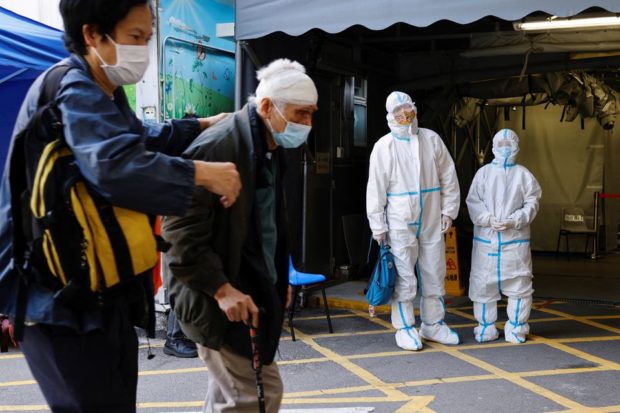
A patient and her relative wearing personal protective equipment (PPE) wait outside the Accident and Emergency (A&E) department, following the coronavirus disease (COVID-19) outbreak, in Hong Kong, China March 4, 2022. REUTERS
HONG KONG — Hong Kong leader Carrie Lam announced a series of measures targeted at elderly residents on Wednesday as a surge of COVID-19 infections sweeps through care homes with deaths rapidly climbing among the city’s mainly unvaccinated seniors.
The government will strengthen medical treatment and resources and set up more isolation and temporary care facilities for elderly coronavirus patients, Lam told a media briefing.
She said a date for a compulsory mass testing scheme, which has triggered panic buying of groceries and essentials in the city, was still being considered but the government had not decided on a timeframe given the huge scale of the operation.
“It is a major exercise which cannot be done overnight. If it is not prepared with all the details and mobilised with all the resources, its not possible.”
Her comments come after a top Chinese official said Hong Kong had to prioritise reducing infections, severe illnesses and deaths.
Infections in the global financial hub have surged to record highs of more than 500,000 cases and more than 2,500 deaths – most in the past two weeks.
The city suffered the most deaths globally per million people in the week to March 7, according to the Our World in Data publication.
Lam who was addressing the media for the first time in over two weeks, said she would be holding daily media briefings to detail the city’s progress against the coronavirus and clarify rumours or misunderstandings.
Residents in the Chinese controlled territory have been confused and frustrated over contrasting messages from the government over the past two weeks about its campaign against the virus, including a plan for mass testing and whether a city-wide lockdown would be imposed.
China and Hong Kong have adopted a “dynamic zero” strategy that involves eliminating infections with strict mitigation measures as opposed to the approach adopted in other places of relying on high vaccination rates and moderate mitigation like masks in an effort to “live with COVID”.
The highly transmissible Omicron variant has tested both strategies but Hong Kong is now suffering the consequences of a relatively low vaccination rate, especially among the elderly, as the virus rips through the community.
About 90.5% of residents have had at least once vaccination but rates for the elderly have severely lagged with only around 50% for those aged 80 years and above.
Medical experts from the University of Hong Kong have estimated that by the end of April the number of people infected in the city of 7.4 million people could be about 4.3 million, with a death toll of 5,000.
Hong Kong’s hospitals, isolation centres and funeral parlours are swamped while public transport, malls, postal services, supermarkets and pharmacies are struggling to operate due to a severe manpower crunch.
Food prices have shot up and supermarket shelves have been emptied every day for a week as shoppers panic buy, on fears of a potential lockdown.
RELATED STORIES
Lockdown fears spark panic buying in Hong Kong
Hong Kong residents brace for citywide lockdown as leader calls for calm
Hong Kong rules out citywide lockdown despite COVID-19 spiral
How COVID-wracked Hong Kong is reeling two years into pandemic


